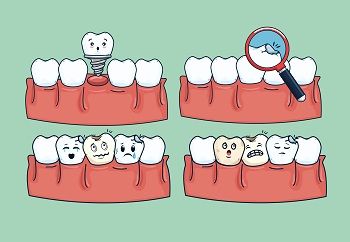What is Orthodontics, and Why Is It Important?
A confident smile is not only aesthetically pleasing, but it also plays a crucial role in our overall well-being. However, many individuals face challenges with misaligned teeth or jaw irregularities that affect their oral health and self-confidence. This is where orthodontics steps in, offering a specialized branch of dentistry dedicated to correcting dental and facial irregularities.
Orthodontics goes beyond mere cosmetic improvements. It focuses on aligning teeth and jaws to achieve a harmonious bite, improved functionality, and a radiant smile that can transform lives. This blog series explores the world of orthodontics, its importance, and how it contributes to oral health and confidence.
Let's discuss what "Orthodontics" means.
Orthodontics is a branch of dentistry that specializes in detecting, preventing, and fixing issues related to the alignment of teeth and jaws. Its main goal is properly aligning teeth and jaws to enhance the mouth's appearance and function. Orthodontic treatment can be used to straighten teeth that are crooked or misaligned, fix bite problems, and improve overall dental health.
Orthodontic Specialists and Their Expertise
Orthodontic treatment requires the expertise of orthodontic specialists, also known as orthodontists. After completing their dental education, orthodontists undergo additional specialized training to diagnose and treat various dental and facial irregularities. They possess an in-depth understanding of dental and craniofacial growth and development, occlusion (the alignment of teeth when the jaws are closed), and the mechanics of tooth movement.
Orthodontic specialists employ various techniques and appliances to correct malocclusions and achieve optimal results. They carefully assess each patient's unique case and provide customized treatment plans to address their needs. With their knowledge and skill, orthodontists guide patients through their orthodontic journey, providing comprehensive care and support.
Common orthodontic Problems
Orthodontics plays a vital role in addressing a range of dental and facial irregularities that can affect oral health and aesthetics. Let's explore some of the most common orthodontic issues that individuals may face:
Malocclusions
Malocclusions refer to improper alignments of the upper and lower teeth when the jaws are closed. They can manifest in various ways, including:
- Overbite: When the upper front teeth protrude over the lower front teeth.
- Underbite: When the lower front teeth extend further out than the upper front teeth.
- Crossbite: Biting down correctly means that the upper teeth are positioned inside the lower teeth.
- Open bite: When there is a space between the upper and lower teeth when biting down, it is referred to as a gap.
- Deep bite: When the upper front teeth excessively cover the lower front teeth when biting down.
Crowding and Spacing Issues
Crowding occurs when there is insufficient space in the dental arch for the teeth to align properly. This can lead to overlapping or rotated teeth. On the other hand, spacing issues arise when gaps or spaces between teeth are often caused by missing teeth or abnormal growth patterns.

Jaw Discrepancies and Facial Asymmetry
Orthodontic issues can also extend beyond the alignment of teeth and involve problems with the jaw and facial structure. Some common jaw discrepancies include:
- Protruding jaw: When the lower jaw extends too far forward, causing an overjet or protrusion.
- Retruded jaw: When the lower jaw is set back, resulting in a receding chin or an underbite.
- Asymmetry: When there is an imbalance in the facial features, such as uneven jaw alignment or a tilted smile.
These orthodontic issues can impact not only the appearance of the smile but also the overall oral health and function. They may contribute to difficulties in chewing, speaking, and maintaining proper oral hygiene. Moreover, untreated orthodontic problems can lead to complications such as temporomandibular joint (TMJ) disorders, tooth decay, and gum disease.
Fortunately, orthodontics offers practical solutions to address these issues, allowing patients to achieve harmonious dental alignment and facial balance. Orthodontists can use various orthodontic techniques and appliances to guide teeth and jaws into proper positions, improving the smile's function and aesthetics.
Importance of Orthodontics
Orthodontics holds significant importance in dental care, offering numerous benefits beyond just the appearance of a straighter smile. Let's explore the key reasons why orthodontics is essential:
Aesthetic Benefits
Orthodontic treatment can transform the appearance of a smile, enhancing facial aesthetics and boosting self-confidence. Straight, properly aligned teeth contribute to a more harmonious facial structure and an attractive smile. The improved aesthetics achieved through orthodontic treatment can positively impact an individual's self-esteem and overall well-being.
Functional Benefits
Orthodontic treatment not only improves the alignment of teeth but also addresses bite abnormalities and jaw irregularities. This can have significant functional benefits, including:
- Improved Biting and Chewing: When teeth are properly aligned, they help improve the ability to bite and chew food effectively by ensuring that the upper and lower teeth meet correctly.
- Speech Improvement: Certain orthodontic issues, such as misaligned teeth or malocclusions, can affect speech clarity. Orthodontic treatment can help correct these issues, leading to improved speech abilities.
- Reduced Teeth Grinding and Jaw Pain: Orthodontic treatment can alleviate the strain on jaw joints (TMJ) and reduce symptoms associated with temporomandibular joint disorders. This may include jaw pain, headaches, and teeth grinding (bruxism).

Oral Health Benefits
Orthodontics plays a crucial role in maintaining optimal oral health by addressing issues that can contribute to dental problems in the long run. Some specific oral health benefits include:
- Prevention of Tooth Decay: Properly aligned teeth are easier to clean, reducing the risk of plaque accumulation and tooth decay. Straight teeth enable better access for brushing and flossing, promoting effective oral hygiene.
- Gum Disease Prevention: Crowded or misaligned teeth can create pockets where plaque and bacteria accumulate, increasing the risk of gum disease. Orthodontic treatment aligns teeth, making maintaining healthy gums easier and preventing gum-related problems.
- Protection Against Tooth Trauma: Teeth that protrude or have irregular positions are more prone to injury or trauma. Orthodontic treatment can reposition teeth, reducing the risk of damage due to accidents or sports-related activities.
By addressing these aesthetic, functional, and oral health aspects, orthodontic treatment is vital in improving overall oral well-being. Through the expertise of orthodontic specialists and various treatment options, individuals can achieve a confident smile, enhanced oral function, and long-lasting oral health benefits.
Who should have orthodontic treatment?
Orthodontic treatment is not limited to a specific age group; children and adults can benefit from it. The decision to undergo orthodontic treatment is typically based on an orthodontic specialist's dental and facial irregularities assessment. Here are some categories of individuals who may benefit from orthodontic treatment:
- Children and Adolescents: Orthodontic treatment for children often begins between the ages of 9 and 14 when the permanent teeth are erupting. Early intervention may be recommended if a child has significant orthodontic issues, such as severe malocclusions, jaw discrepancies, or crowding. Early treatment aims to guide proper dental and jaw development, potentially reducing the complexity of future orthodontic interventions.
- Teenagers: Teenagers commonly undergo orthodontic treatment during their adolescent years. This is when most permanent teeth erupt, providing orthodontists with a comprehensive view of the dental and skeletal structures. Treatment during this stage can address many orthodontic issues, including malocclusions, crowded teeth, and bite abnormalities, enhancing oral health and aesthetics.
- Adults: Orthodontic treatment is not limited to childhood and adolescence. Many adults seek orthodontic care to correct long-standing orthodontic issues never addressed earlier or improve their smile's appearance and function. Advancements in orthodontic techniques, such as clear aligners and discreet braces, have made treatment options more appealing for adults, allowing them to achieve their desired results with greater convenience and aesthetic appeal.
It is important to note that while orthodontic treatment can benefit most individuals, it is not suitable for everyone. A thorough evaluation by an orthodontic specialist is necessary to determine if someone is the right candidate for treatment. Factors such as overall oral health, the severity of orthodontic issues, and individual treatment goals will be considered when deciding whether to proceed with orthodontic treatment.
In brief, orthodontic treatment is appropriate for individuals of all ages, including children, teenagers, and adults, who have dental or facial irregularities that can be resolved with orthodontic measures. Consulting an orthodontic specialist will allow patients to receive customized treatment plans that address their unique concerns, resulting in a healthier, more pleasant smile.
Contact your Danville dentist, Dr. Hoss Abar, DDS, MSD, at Danville Orthodontics to learn more about Orthodontics and Why it is important.
Resource:
Orthodontic treatment options for adults
This media/content or any other on this website does not prescribe, recommend, or prevent any treatment or procedure. Therefore, we highly recommend that you get the advice of a qualified dentist or other medical practitioners regarding your specific dental condition.
